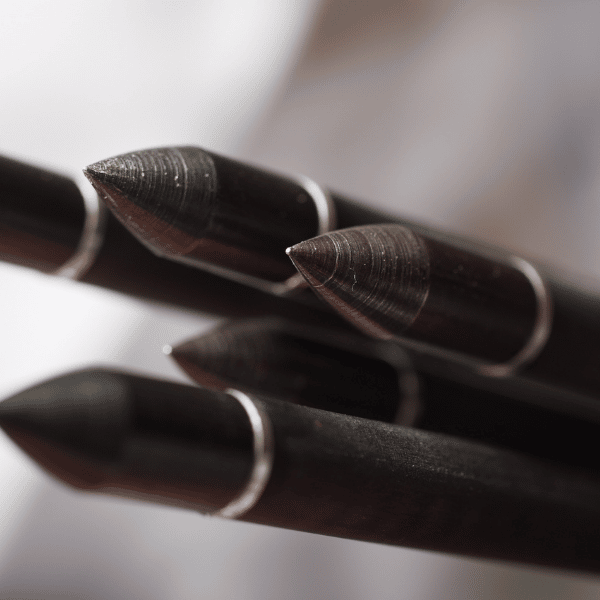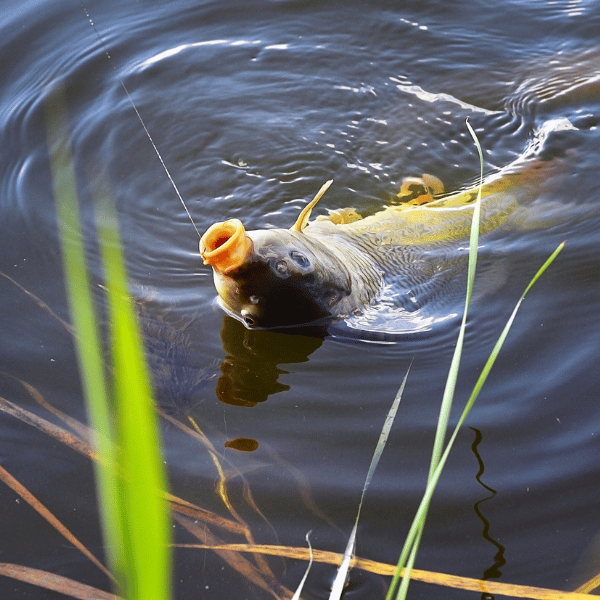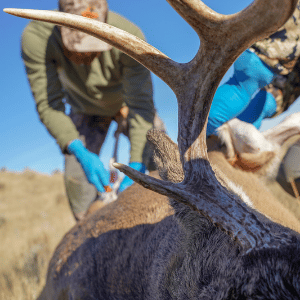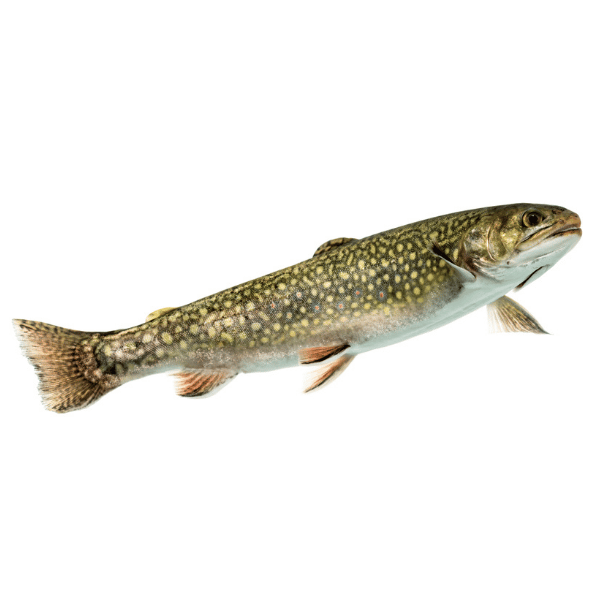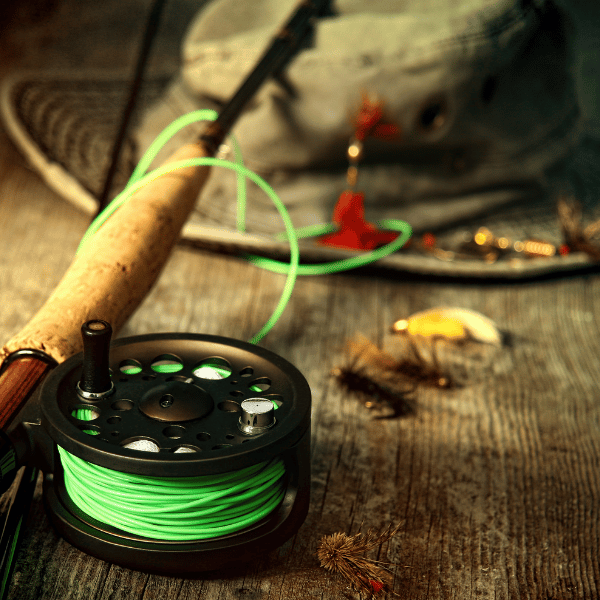How To Fly Fish In Winter
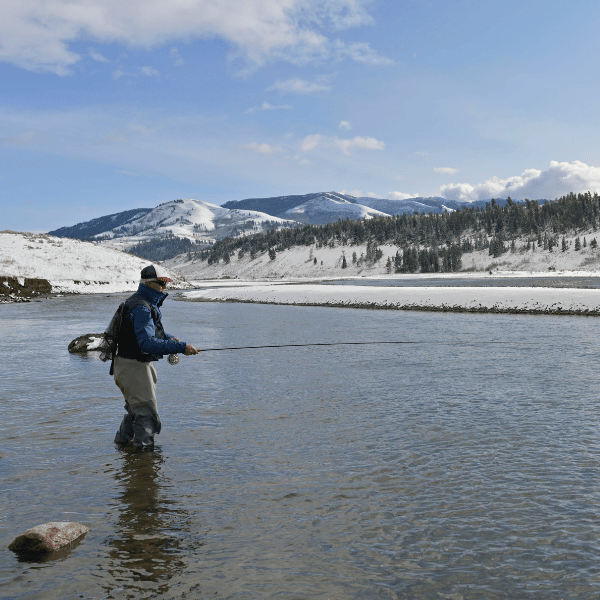
If you are planning on fly fishing in the winter, then this guide might help you out. It may seem like a strange time to go fishing, but most of the moving water won’t be freezing unlike some bodies of water.
Fly fishing is perfect when you are working with rapidly moving waters. But is it challenging to do even in the wintertime?
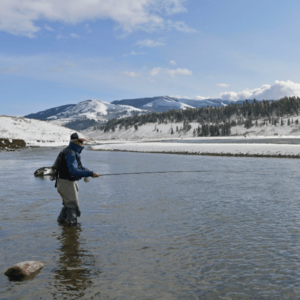
It might be better than ice fishing (or it may be not cold enough where the water doesn’t freeze at all). We’ll talk about the basics of winter fly fishing and the kind of flies you can use that will be best.
You will also need gear of your own so you stay warm and dry while fishing. Plus, you’ll learn some safety tips that you might not want to ignore.
If you want to do some winter fly fishing, keep reading.
Contents
Basics of Winter Fly Fishing
As a beginner, the basics are all you need to know. Once you get the hang of it all, you’ll be able to learn a few advanced tactics.
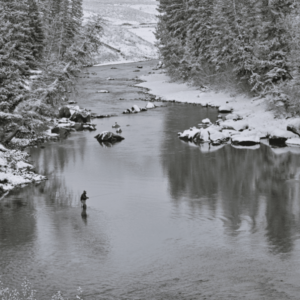
Our goal is to make it easier on you so you’ll have a fun time trying out fly fishing during a time of the year where it’s a bit unusual compared to the summer months. Here are some basic things to know about winter fly fishing:
Less traffic means more fish: Most of the time, fly fishing will happen during the warmer months. And that means more people will be out and about using their rods. In the winter, it’s the opposite. So with less people fishing, there will be more chances to get as many hits as you like.
Watch the weather reports: Cold temperatures may either be a blessing or a curse when it comes to fly fishing. Weather and timing go hand in hand. On days prior to a snowstorm, this will be the perfect time to do some fishing. Also, light snowfall will be the perfect time for fly anglers. That’s because the temperatures won’t be ridiculously cold.
Stick to large, deep fishing holes: Your best bet for catching fish in the winter will be in areas that are large in size and deep. That’s where the fish will be gathering when the temperatures are much colder. Fast and shallow waters will be unproductive in the winter.
Find warmer waters: Water freezes when the air temperature is 32 degrees. But what’s amazing is the water can get a lot colder in temperature compared to the air. Keep in mind that the higher the air temperature is, the less cooler the water will be.
Types of Fish to Catch Fly Fishing In The Winter
What exactly can you catch fly fishing in the winter?
You can catch plenty of fish in the wintertime depending on where you are.
Here are some of the species that you will be able to catch in the winter with flies:
Rainbow Trout: Trout will usually be moving around underwater especially during the winter months. Typically they will rise to the surface when there are midges and mayflies appearing on the surface.
Steelhead: Aside from rainbow trout, you may catch a few steelheads during the winter months.
Best Winter Fly Fishing Flies
There are three types of flies that will work great when fly fishing in the winter: nymphs, dries, and streamers. We’ll be taking a look at some of our favorite flies from each type so you’ll know what to bring with you during some winter fly fishing.
Do not leave home without these flies or you will have a difficult time catching the fish you want. Here are some flies that we highly suggest you choose:
ICSI (I Can See It) Midges: Trouts are responsive to midges. And this kind is perfect for trout fishing. These are popular due to its orange parachute-like post which makes it easy to spot while on the water.
Griffith’s Gnats: When adult midges travel across the water, they will usually move in clumps. The more midges that are present, the better it is for trout to pop up. Use this and you might be almost guaranteed a few bites.
Disco midge: These are perfect whenever you want the closest thing to midge pupae. Since these hatch most of the time in the winter, they will be perfect when you are fishing in tailwaters. If you are in deep fishing holes and want to trigger a few risers, you’d be hard-pressed to find a fly quite like this anywhere else.
English Pheasant Tail Nymph: Since trout love mayflies, then it would be smart to find something close enough to it. These English Pheasant Tail Nymphs might just do the trick. Plus, they are bulkier than regular mayflies and even small brown stoneflies that are usually present in the wintertime.
Micro Stone: Stoneflies are usually active in the wintertime (specifically the nymphs). They become a favorite among hungry trout. Want to really get a few hits? Micro stones might be your best friend here.
Winter Fly Fishing Gear To Stay Warm
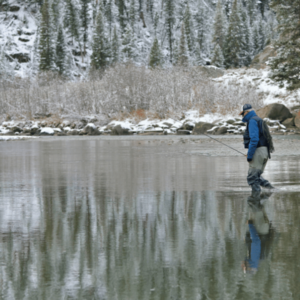
Obviously, winter fly fishing cannot be possible without knowing some of the few common-sense safety tips. One all-important tip that cannot be ignored is the need to stay warm when the temperatures get really cold.
Hypothermia is not only something you don’t want to deal with, but it can be fatal if left untreated. Not to mention, you also want to prevent frostbite.
We’ll be taking a look at some gear that will help you keep warm and stay protected against the elements during the winter months. Here is some of the gear you’ll need to take with you:
Long underwear/”Long Johns”: There’s no such thing as having too many layers. The more you have on, the better the chance you’ll stay warm. This will more than likely become your base layering since you will be piling on more gear beyond that. Use long underwear that is made from synthetic fabrics. They are more durable and will last a lot longer than cotton.
Thermal socks: You’ll need to take good care of your feet rather than let them freeze underneath your boots. Your boots can only do so much regardless of how much insulation it has. Find a thick pair of thermal socks that will keep your feet warm enough to sustain low temperatures (especially temperatures that are below freezing).
Neoprene Waders: There’s a good enough chance that you will be spending time in the water. You may be ankle or even knee-deep in it. So having a good pair of waders on hand will work to your advantage. Neoprene is a great material since it’s breathable. Plus, it provides you with a great layer of protection from cold water temperatures.
Down jacket or parka: A nice thin down jacket or parka might be what you need to stay warm on most days. It doesn’t need to be bulky to a point where it will restrict your movement. While it should be thin, it should also be enough to insulate your upper body. Find one that will fit you best and be on the lookout for “stretch technology”. If it can stretch, you can get a good fit-out of it.
Fingerless or half-finger gloves: Full-fingered gloves won’t do you any good when you are holding a fishing rod. So your best bet will be fingerless or half-finger gloves. These gloves will come in a wide variety of materials. But it can also help improve the dexterity in your hands as well so you can handle the rod or even tie on some flies. If you are struggling to choose a material, wool will be your go-to since it’s guaranteed to keep you warm.
Wool hat and head sock: Last but not least, you’re going to need a hat and a head sock to keep warm. You lose a good amount of body heat from that part of your head. As mentioned before, wool is a proven ally in the war against cold weather. A head sock must also be worn underneath the hat. The head sock should be made from fleece. Don’t settle for any other material.
Winter Fly Fishing Safety
To ensure that you use your common sense and stay safe while fly fishing in the wintertime, it is important to know some of the following safety tips:
- When in doubt, don’t. It won’t be worth crossing the river if the conditions are not favorable.
- Never stand on ice shelving, even if it’s above several feet of water. The ice may collapse and could put you at risk for drowning.
- If the water and air temperatures are below freezing, do not do any “deep wading” or bring the water up to knee depth. When wading, make sure you are in a shallow spot.
- Always bundle up and stay warm. Don’t stay outdoors for longer periods of time so you don’t risk hypothermia.
